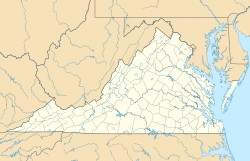United States historic place
| Marlbourne | |
| U.S. National Register of Historic Places | |
| U.S. National Historic Landmark District | |
| Virginia Landmarks Register | |
  | |
| Location | U.S. Route 360, Hanover County, Virginia |
|---|---|
| Nearest city | Richmond, Virginia |
| Coordinates | 37°39′15.13″N 77°13′20.92″W / 37.6542028°N 77.2224778°W / 37.6542028; -77.2224778 |
| Built | 1843 |
| NRHP reference No. | 66000837 |
| VLR No. | 042-0020 |
| Significant dates | |
| Added to NRHP | October 15, 1966 |
| Designated NHLD | July 19, 1964 |
| Designated VLR | September 9, 1969 |
The Edmund Ruffin Plantation, also known as Marlbourne, is a U.S. National Historic Landmark in Hanover County, Virginia, 11 miles (18 km) northeast of Richmond.
History
Built in 1840, the plantation was purchased in 1843 by Edmund Ruffin, a Virginia planter and a pioneer in agricultural improvements; he also published an agricultural journal in the 1840s named the Farmer's Register. One of a group of intellectuals they called "the sacred circle", he worked to reform agriculture in the South, promoting crop rotation and soil conservation; he is considered to have been "the father of soil science" in the United States. Ruffin experimented with agricultural methods and mixed marl, defined as "a friable earthy deposit consisting of clay and calcium carbonate, used esp. as a fertilizer for soils deficient in lime" to add to soils.
He and his friends: James Henry Hammond, Nathaniel Beverley Tucker, George Frederick Holmes, and William Gilmore Simms, were pro-slavery and promoted a moral reform of the South. They published numerous articles in literary and short-lived magazines, promoting a stewardship role for masters to improve conditions under slavery.
Later Ruffin gained more attention as one of a number of secessionist fire-eaters; he traveled to South Carolina and is credited with firing one of the first shots at Fort Sumter in 1861. Despondent after General Lee's surrender in 1865, he left a note proclaiming his "unmitigated hatred to Yankee rule—to all political, social and business connections with Yankees, & to the perfidious, malignant, & vile Yankee race" and committed suicide at Redmoor in Amelia County. He is buried on the grounds of Marlbourne.
His Marlbourne plantation was declared a National Historic Landmark in 1964.
See also
- List of National Historic Landmarks in Virginia
- National Register of Historic Places listings in Hanover County, Virginia
References
- "Virginia Landmarks Register". Virginia Department of Historic Resources. Archived from the original on September 21, 2013. Retrieved June 5, 2013.
- "National Register Information System". National Register of Historic Places. National Park Service. January 23, 2007.
- ^ "Marlbourne". National Historic Landmark summary listing. National Park Service. Archived from the original on December 29, 2007. Retrieved April 11, 2008.
- Charles B. Dew, "Review: 'A Sacred Circle: The Dilemma of the Intellectual in the Old South, 1840-1860' by Drew Gilpin Faust", The Florida Historical Quarterly, Vol. 58, No. 4 (April 1980), pp. 445-447
- Ruffin, Edmund. Nature's Management: Writings on Landscape and Reform, 1822-1859, edited by Jack Temple Kirby, University of Georgia Press, 2006
- Drew Gilpin Faust, A Sacred Circle: The Dilemma of the Intellectual in the Old South, 1840-1860, University of Pennsylvania Press, 1977
- Drew Gilpin Faust, The Ideology of Slavery: Proslavery Thought in the Antebellum South, 1830--1860 (Google Ebook), LSU Press, 1981
- Walther, Eric (1992). The Fire-Eaters. Louisiana State University Press. pp. 228-. ISBN 0-8071-1775-7.
- Lee, Anne Carter (June 18, 2018). "Redmor". Society of Architectural Historians Archipedia. Society of Architectural Historians/University of Virginia Press. Retrieved November 11, 2021.
- Lissandrello, Stephen (December 16, 1974), National Register of Historic Places Inventory-Nomination: Marlbourne (Edmund Ruffin Plantation) (pdf), National Park Service and Accompanying five photos, exterior, from c. 1970 (32 KB)
External links
- Photo at Virginia DHR
- Diary records of Ruffin's son, Edmund Ruffin, Jr., survive and describe events at this and other Ruffin plantations: Records of Ante-Bellum Southern Plantations From the Revolution Through the Civil War
- Marl defined at www.dictionary.com
- Edmund Ruffin at another encyclopedia, mentioning his use of marl
- 1823 establishments in Virginia
- Georgian architecture in Virginia
- Greek Revival houses in Virginia
- Historic districts on the National Register of Historic Places in Virginia
- Houses completed in 1843
- Houses in Hanover County, Virginia
- Houses on the National Register of Historic Places in Virginia
- National Historic Landmarks in Virginia
- National Register of Historic Places in Hanover County, Virginia
- Plantations in Virginia

